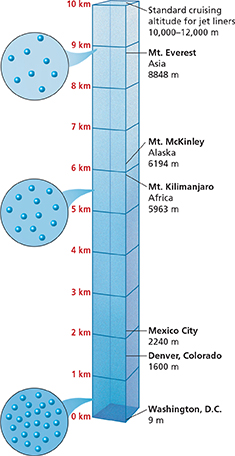Air Pressure
The atmosphere has weight because of Earth's gravity. As a result of this weight, the atmosphere exerts pressure. Recall that pressure is the force exerted on a surface divided by the area over which the force is exerted. Air pressure is the force exerted by the weight of a column of air on a surface. At sea level, air pressure is about 101,325 newtons per square meter, more commonly expressed as 1013.25 millibars. One millibar equals 100 newtons per square meter.
Effect of Altitude
Air pressure changes with altitude. The atmosphere is densest near Earth's surface and becomes less dense as altitude increases, as shown in Figure 3. Why is this? Air can be compressed, as it is when you pump air into a tire or a basketball. Near Earth's surface, the column of air includes the entire depth of the atmosphere, so the pressure and density are high. As altitude increases, the depth of the column of air above decreases, so the pressure decreases. At high altitudes there is very little air in the column above, so air pressure is lower.  As altitude increases, air pressure and density decrease.
As altitude increases, air pressure and density decrease.
About half of the total mass of the atmosphere is found below an altitude of 5.6 kilometers. When Hillary and Tenzing climbed Mount Everest, they went well above this halfway point. As they climbed, the air became less dense. Hillary had trouble breathing without an oxygen mask because there were many fewer oxygen molecules per cubic meter of air at the summit than at sea level.
Figure 3 The atmosphere is densest close to Earth's surface. Applying Concepts How does air pressure change as altitude increases?
 d
dMeasuring Air Pressure
Scientists measure air pressure with an instrument called a barometer. The first barometer was invented in 1643 by the Italian scientist Evangelista Torricelli. Torricelli invented a mercury barometer, similar to the one shown in Figure 4. As air pressure increases, the column of mercury in the barometer rises. As air pressure decreases, the column of mercury falls. Thus, a measurement of the height of a column of mercury is a measurement of air pressure. At sea level, the average air pressure is about 760 millimeters of mercury or, more commonly, 29.92 inches of mercury.
An aneroid (AN uh royd) barometer is a smaller, more portable type of barometer. The word aneroid means “not using liquid.” Aneroid barometers use a metal chamber that expands and contracts with changes in air pressure.





